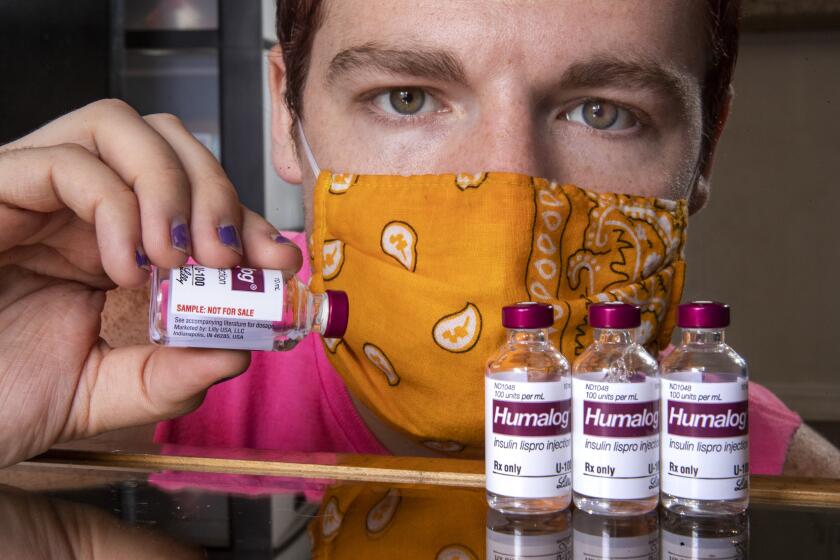Op-Ed: Mark Cuban won’t fix our drug pricing problem

- Share via
Mark Cuban, the billionaire “Shark Tank” celebrity and Dallas Mavericks owner, is getting attention again — this time for his Mark Cuban Cost Plus Drug Co., which seeks to reduce prescription drug prices for Americans. A new study finds that Medicare could have saved $3.6 billion in 2020 if it had paid Mark Cuban drug prices.
This finding has been hailed as big news, reflecting the fact that Americans reliably consider prescription drug costs a high-priority issue. CBS reported that Cuban aims to turn the industry “upside down.”
Savings from Cuban’s prices would be welcomed. His website adds to services from Walmart and Costco that sell discounted generic drugs (researchers reported last year that Costco prices also could have saved Medicare billions).
The copay coupon scheme is lucrative for pharmaceutical companies, which disburse money to subsidize patient copays as a form of what they characterize as charity.
However, Cuban’s service currently covers only older generic drugs. Those should be cheap to begin with because their manufacturers no longer hold patents or other protections that prevent generic manufacturers from providing inexpensive copies. But their prices can be driven up. Sometimes, that’s because the drugs treat rare conditions with small markets that discourage competition. But it’s also because wholesalers, pharmacies and middlemen called pharmacy benefit managers can pocket nearly two-thirds of a drug’s price, the sort of price inflation Cuban’s service seeks to avoid.
Still, the drug cost problem goes far beyond these generics: Medicare spent $183 billion total on drugs in 2019, while the country as a whole spends half a trillion dollars annually. Of prescription drug expenditures in the U.S., generic drugs account for only about 20%. The other 80% is for brand-name drugs.
Brand-name drugs command high prices because their developers still enjoy monopolies on their production and sale. These monopolies reflect intentional and longstanding government policies to incentivize research investments by rewarding drug developers with substantial profits for new drugs that improve health and extend lives.
But that does not mean the sky should be the limit on brand-name prices. It is, of course, possible to pay too much and, consequently, incentivize wasteful spending by drug companies on drugs that have too small a chance of working, or that produce health benefits that are too limited even if the new drugs work.
Cuban says he plans to add brand name drugs to his service. But it’s unclear when that will happen, and any savings his company achieves likely will be modest.
So the long-term question remains: How to set prices that are high enough to induce drug companies to make worthwhile investments while not giving away the store? Paying too little fails to suitably incentivize the industry to develop new drugs (a process that can cost a billion dollars or more). Paying too much diverts resources from better uses elsewhere.
To strike the right balance, policymakers should look to value-based drug pricing — that is, pricing drugs according to the health benefits they deliver. Formal cost-effectiveness analysis compares a drug’s cost — accounting for savings the drug can create elsewhere, such as by reducing expensive hospitalizations — to its benefits, including extended life expectancy and improved quality of life. This analysis offers a systematic approach for identifying suitable prices.
Newsom wants to spend $100 million to make insulin affordable to millions with diabetes under a new generic drug label, CalRx. What will it cost?
Organizations such as the nonprofit Institute for Clinical and Economic Review in Boston, the National Institute for Health and Care Excellence in Britain and other agencies around the world have demonstrated that such information can help inform appropriate pricing. Unlike its international counterparts, ICER, in Boston, has no formal authority to negotiate prices. Still, public and private health insurers are using ICER’s information as a factor in decisions about prices and policies for fair access to new medications.
Analyses by these groups do not single-mindedly push for lower prices. Instead, they recommend paying more when the benefits warrant it. For example, a recent ICER review concluded that a new gene therapy for a rare blood disorder would provide good value, even at a one-time cost for a single patient exceeding $2 million (presumably to be covered by insurance). On the other hand, ICER panned the first new therapy for Alzheimer’s disease in decades because it concluded that the annual price of about $50,000 was not aligned with the limited benefit suggested by the clinical evidence.
Such approaches are not perfect. But methods are improving, particularly efforts to more fully account for the benefits of medications, including, for example, reduced burdens for caregivers and families as well as economic benefits for society at large. The alternative to formal analysis is to trust people’s flawed hunches about a drug’s value, a path more susceptible to the sway of interest groups.
Value-based drug pricing by itself will not make all needed medications affordable. Other policies must ensure that people have adequate health insurance coverage that eliminates excessive co-payments and other barriers to accessing worthwhile therapies. There is evidence that insurers are reducing access or dropping coverage altogether for some drugs based on cost, rather than considerations of value for patients.
Efforts such as the Mark Cuban Cost Plus Drug Co. can help bring cost relief to many Americans for generic medications they rely on.
But the much larger issue of brand-name drug pricing desperately needs attention too. Value-based pricing and insurance reform could make these costly medications more affordable — and create better incentives to produce more of the drugs we need and less of the ones we don’t.
Peter Neumann, Joshua Cohen and Daniel Ollendorf are the authors of “The Right Price: A Value-Based Prescription for Drug Costs” and members of the Center for the Evaluation of Value and Risk in Health at Tufts Medical Center.
More to Read
A cure for the common opinion
Get thought-provoking perspectives with our weekly newsletter.
You may occasionally receive promotional content from the Los Angeles Times.












